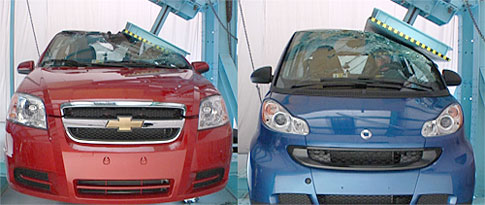Smart ForTwo looks good in roof-strength crash test
Posted By RichC on August 20, 2009

One has to think twice before grimacing when seeing those tiny Smart ForTwo car(t)s rolling down the highway … especially if you’re in a bow-tied import like the Chevrolet Aveo (Daewoo Korean built Chevrolet). A recent report issued by the Insurance Institute for Highway Safety (IIHS) found that the Smart ForTwo performed the best in tests designed to compare rollover occupant protection, where the Aveo received only a “marginal” rating.
News Release | August 20, 2009
Smart Fortwo rates good for roof strength; test is designed
to assess & compare occupant protection in rollover crashesThe Smart Fortwo has the strongest roof and the Chevrolet Aveo has the weakest among 2009 micro and minicars recently tested by the Insurance Institute for Highway Safety. The Smart earns the highest rating of good compared with acceptable for the Honda Fit, Hyundai Accent, Mini Cooper, and Toyota Yaris. The Aveo is rated marginal.
The rating system is based on Institute research showing that occupants in rollover crashes benefit from stronger roofs. Vehicles rated good must have roofs that are more than twice as strong as the current minimum federal safety standard requires. The ratings, products of the Institute’s new roof strength testing program, add to consumer information tests that rate vehicles for front, side, and rear crashworthiness. The roof test is designed to help consumers pick vehicles that will help protect them in rollover crashes.
“We anticipate that our roof strength test will drive improved rollover crash protection the same way our frontal offset and side tests have led to better occupant protection in these kinds of crashes,” says Institute president Adrian Lund.
Roofs have gotten stronger during the past few years, Institute research shows. Part of the reason is that automakers have made structural improvements to earn better front and side ratings in Institute tests. Strong A and B pillars help prevent intrusion in these types of crashes. They also help hold up the roof.
“Small cars should have an easier time with the roof strength test,” Lund explains. “Their light weight means their roofs don’t have to work as hard to keep the structure around the occupants intact in a rollover.”
About 10,000 people a year are killed in rollovers. When vehicles roll, their roofs hit the ground, deform, and crush. Stronger roofs crush less, reducing the risk of injury from contact with the roof itself. Stronger roofs also can prevent people, especially those who aren’t using safety belts, from being ejected through windows, windshields, or doors that have broken or opened because the roof deformed. Roofs that don’t collapse help keep people inside vehicles as they roll.
The best protection is to keep vehicles from rolling in the first place. Electronic stability control is significantly reducing rollovers, especially fatal single-vehicle ones. When vehicles do roll, side curtain airbags help protect people. Belt use is essential.
How roofs are evaluated: In the Institute’s test, a metal plate is pushed against 1 side of a roof at a constant speed. To earn a good rating, a roof must withstand a force of 4 times the vehicle’s weight before reaching 5 inches of crush. This is called a strength-to-weight ratio. For an acceptable rating, the minimum required ratio is 3.25. A marginal rating value is 2.5. Anything lower than that is poor.
“Compared with the current federal standard of 1.5, a strength-to-weight ratio of 4 reflects an estimated 50 percent reduction in the risk of serious or fatal injury in single-vehicle rollover crashes,” Lund explains.
The Smart withstood a force of 5.4 times its weight. The Aveo withstood a force of just over 3 times its weight.
Cars have been built to meet the same roof crush standard, Federal Motor Vehicle Safety Standard 216, since 1973. The rule was extended in 1994 to include all passenger vehicles up to a gross weight rating of 6,000 pounds. Many SUVs and pickup trucks are heavier, so they’re exempt.
New federal requirements: In April the National Highway Traffic Safety Administration ended numerous delays by unveiling a new rule that doubles the current roof strength requirement (strength-to-weight ratio of 1.5) for vehicles with weight ratings up to 6,000 pounds. Roofs on vehicles with weight ratings 6,000 to 10,000 pounds will be required to withstand a force equal to 1.5 times their unloaded weight. Another requirement is that roofs maintain sufficient headroom during testing. For the first time, the government also will require the same performance on both sides of the roof when tested sequentially. Phase-in begins in September 2012, and all vehicles must comply by September 2016.
“The federal government’s leisurely phase-in of the new standard means roofs won’t have to get stronger right away,” Lund says, “so we plan to continue rating vehicle roof strength for the foreseeable future. We want to reward manufacturers who are ahead of their competition when it comes to providing protection in rollover crashes. We want to help consumers identify the safest vehicle choices.”
Roof ratings added to award criteria: A good roof strength rating will be a new requirement to earn the Institute’s Top Safety Pick award for 2010. This is the second time criteria for this award have been tightened since the first winners were announced in 2005. Availability of electronic stability control became a requirement starting with 2007s.
“Adding roof strength to Top Safety Pick criteria means we’re going to see fewer winners in 2010,” Lund points out. A record 84 vehicles have qualified for the 2009 award so far.
Comments